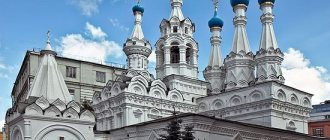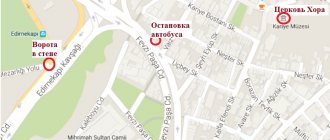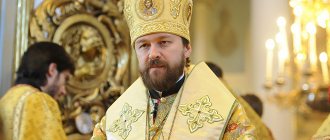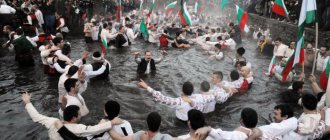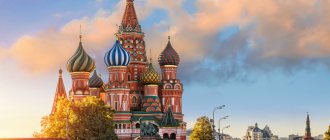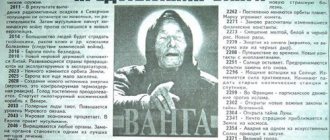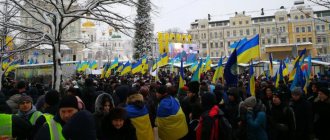| Coptic Orthodox Church | |
| Copt. Ϯⲉⲕ̀ⲕⲗⲏⲥⲓⲁ ⲛⲣⲉⲙ̀ⲛⲭⲏⲙⲓ ⲛ̀ⲟⲣⲑⲟⲇⲟⲝⲟⲥ | |
| St. Mark's Cathedral in Cairo | |
| General information | |
| Founders | Apostle Mark |
| Base | |
| Management | |
| Primate | Theodore II |
| Center | Alexandria |
| Primate's residence | Cairo |
| Territories | |
| Jurisdiction (territory) | Africa (excluding Ethiopia and Eritrea) |
| Autonomous churches in canonical dependence | French |
| Divine service | |
| Liturgical language | Coptic, Arabic, English |
| Calendar | Coptic |
| Website | copticpope.org |
| Media files on Wikimedia Commons | |
| Information on Wikidata? | |
Coptic Orthodox Church of Alexandria
(Coptic
Russian Orthodox Church
"
)
is the Christian Church of Egypt, belonging to the group of Ancient Eastern (non-Chalcedonian) churches. Like all other Ancient Eastern churches (except for the Assyrian Church of the East), the Coptic Church recognizes the decisions of the three Ecumenical Councils, adheres to the Miaphysite Christology traditional for the Alexandrian theological school and is not part of the family of local Orthodox churches of the Byzantine (Chalcedonian) tradition. The Coptic rite is used in worship.
According to the historiography accepted in the Coptic Church, the church was founded, according to legend, by the Apostle Mark in the middle of the 1st century in Alexandria, to the episcopal see of which the Coptic patriarch traces his succession. It took shape as a distinctive autocephalous church as a result of the division in the 6th century of the single church in Africa (the Patriarchate of Alexandria) into two sees - Chalcedonian (Dyophysite) and non-Chalcedonian (Miaphysite). In the 4th-7th centuries, it spread its influence to Ethiopia and Nubia, as a result of the Christianization of the Axumite kingdom and the Nubian kingdoms of Nobatia, Alodia and Makuria (the latter initially recognized the authority of the Church of Constantinople). In the 7th century, Egypt was captured by Muslim Arabs, after which the Coptic Church experienced both periods of persecution and relative religious tolerance. In the 12th century, the religious center of the Church moved from Alexandria to Cairo, and Coptic Christians became a religious minority in Egypt. In the 14th and 15th centuries, Christianity almost completely disappeared from Nubia. In 1959, the autocephaly of the Ethiopian Church was guaranteed.
The highest governing body is the Holy Synod, which is presided over by the Patriarch, who has his residence in Cairo. The new residence of the patriarch is proposed in the new capital of Egypt, where the Cathedral of the Nativity was opened in January 2021.[3] Since November 18, 2012, Patriarch - Theodore II. Currently it has 18-22 million believers and 400 communities, most of them in Egypt, the rest in the Egyptian diaspora.
Relations with the Russian Orthodox Church
Patriarch Kirill, at a meeting with the Pope of Alexandria and the Patriarch of the See of St. Mark Shenouda III in Alexandria, stated that the Russian Orthodox Church and the Oriental churches (the ancient Eastern churches, to which the Coptic belongs) “were and are in a state of theological dialogue.” Patriarch Kirill presented Patriarch Shenouda as a souvenir of this meeting, a symbol of hierarchal service and hierarchal power - the patriarchal staff, with the words:
Leaning on this staff, remember that you have brothers on whom you can also lean[5].
Story
K. c. traces its history back to the ap. Mark, who, according to Sacred Tradition, created the Christian community in Egypt ca. 48. To ser. 5th century Christianity was practiced by the vast majority of the Egyptian population. In con. 440s the Alexandrian Patriarch Dioscorus (444–451) took the side of the archimandrite of one of the Constantinople monasteries, Eutyches, who taught about the one Divine nature of Christ (see Monophysitism). Dioscorus's speech led to a schism in the Alexandrian Orthodox Church. The teaching supported by Dioscorus prevailed at the Council of Ephesus (449), but was condemned by the IV Ecumenical Council of Chalcedon (451), which developed the Orthodox teaching about the union of two natures (Divine and human) in Christ. Dioscorus was deposed and sent into exile; in his place the emperor appointed a new patriarch, not recognized by the majority of Egypt. laity and clergy.
Beginning in 451, non-Chalcedonian doctrines were accepted by the majority of Egyptians. In the 6th century. the non-Chalcedonites arose a separate hierarchy, from that time on we can talk about them being independent. Churches. The “non-Chalcedonian” clergy of Egypt intensified their preaching activities in Ethiopia, Nubia and some other regions of Africa. In the 520s–530s. Egypt The church suffered a number of schisms. The crisis was aggravated by persecution, which intensified under the emperor. Justinians I (527–565). A new round of persecution from the Byzantines. authorities fell on the 620–630s. After the conquest of Egypt by the Arabs in 641 Egypt. Christians took advantage of the current situation to break all contacts with Byzantium. The clergy returned to the churches, and Anti-Chalcedonian Christians occupied most positions in the local administration. At the same time, there was no need to conduct polemics with Byzantium. The church caused the decline of Egypt. theological literature. In the first centuries Arab. dominion, the name Copts was assigned to the autochthonous Egyptians, and to Egypt. The Anti-Chalcedonian Church is the Coptic Church.
K.Ts., based on the formula “the one nature of God the Word incarnate” (μία φύσις τοῦ Θεοῦ Λόγου σεσαρϰωμένη), recognizes the unity of Christ (μία φύσις), formed by the inextricable fusion of God natural and human essences “without confusion and without change.” Thus, from the point of view of the strict Christological terminology of K. ts. is miaphysite, although in Europe. ecclesiastical and historical traditions of the 19th century often called Monophysite. K. c. herself. recognizes Monophysitism as a heresy, blaming the Byzantines. The Church deliberately distorts the meaning of its teachings.
Coptic Church of Our Lady (al-Muallaqa) in Cairo. 4th–7th centuries
From the beginning 8th century The conquerors began to pursue a policy of Arabization of the country, ousting the Coptic language, as well as Christian officials from government bodies. The introduction of social and everyday restrictions and the need to pay a poll tax pushed Copts to convert to Islam. In the 9th century Christians became a minority of the Egyptian population. Nevertheless, in the 8th–12th centuries. Muslim the authorities were distinguished by a high level of religious tolerance, with the exception of the reign of the Fatimid caliph al-Hakim (996–1021), who subjected the Coptic community to religion. persecution. Patriarch Christodoulos (1047–77) transferred the residence of the primates of the K. ts. from Alexandria to the capital Cairo, thereby bringing the administration of the Church closer to Egypt. authorities and at the same time symbolically emphasizing the isolation of K. c. from Orthodox churches. 12th–13th centuries - a short period of revival of Coptic theology, apologetics, church history. science and canon. rights. Between 1279 and 1447, the Mamluk rulers of Egypt spent c. 8 campaigns to expel Coptic employees from government. fasts and tightening of social and everyday restrictions imposed on Christians. The persecution led to a sharp reduction in the number of church churches, the closure of churches and monasteries, and the decline of church science. In the 14th century chroniclers' recording of church history is interrupted. Gradual restoration of political and economical positions of the Coptic community, revitalization of the spiritual life of the K. c. occurred in the 17th–18th centuries. Beginning with Patriarch Butrus VII (1809–1852), the Coptic clergy began to regain its lost influence and authority in the eyes of Egypt. authorities.
The reigns of Muhammad Ali (1805–49), Said Pasha (1854–63) and Khedive Ismail (1863–79) became an era of active integration into social and political circles for Christian Copts. Egyptian institutions. Important milestones in this process were the abolition of the poll tax (jizya) against Coptic Christians, the extension of military service to them, and entry as delegates into Egypt. Advisory Board. The presidency of Patriarch Cyrillus IV (1854–61), who later received the title “Father of Coptic Reformation,” was marked by a foundation. transformations in the fields of education, printing and worship. In the last quarter 19th – 1st third of 20th centuries. The confrontation between the patriarchy and the Coptic secular elite, which established al-Majlis al-Milli (Community Council) in 1874, intensified. At the same time, Western proselytizing activity intensified in Egypt. churches. Renewed in the 2nd half. 16th century contacts with Rome. throne ended in a split in the K. ts. and the formation in 1895 of the Uniate Patriarchate of Alexandria. In 1899, from part of the flock of K. ts. A Protestant (Presbyterian) denomination was formed, which later received the name. Evangelical Church of Egypt - Synod of the Nile.
The reign of King Farouk of Egypt (1936–52) saw a rise in Islamist sentiment, which was accompanied by the gradual displacement of Copts from societies. and political life of Egypt. At the same time, the crisis in the Catholic Church deepened, reaching its peak during the period when the patriarchal see was vacant (1942–1944), and during the primacy of Makarius III (1944–45) and Yusuf II (1946–1956), who was deposed on charges of simony. Emigration began among Copts to European countries and the United States, where an influential Coptic diaspora was formed. The period of the primacy of Cyrillus VI (1959–71) became the era of the rise of the Coptic Church: the restoration of monasteries, the revival of Coptic monasticism. Active society. and does charity. activities of K. c. was accompanied by her involvement in interfaith dialogue in the country and abroad. Egyptian President G. A. Nasser personally laid the first stone for the construction of the Coptic Cathedral of St. Mark in Cairo, where in July 1968 part of the relics of St. Mark was solemnly returned from Italy. Brand. Patriotic the mood of the Coptic clergy and community manifested itself during the wars with Israel in 1956 and 1967, Muslim-Christian demonstrations of nationalism were held. solidarity.
The Primate of the Coptic Church is Patriarch Shenouda III. Photo by Michael Sleman
Elected Patriarch Shenouda III in 1971, he continued his efforts to strengthen the Church. Its numerous. visits abroad contributed to the unity of the Coptic diaspora. Shenouda III, who headed the monthly meetings of al-Majlis al-Milli, managed to exhaust the confrontation between the patriarchy and the secular leadership of the Coptic community and strengthen the position of the K. c. as a symbol of community identity. At the same time, the growth of Islamist sentiments in Egypt during the reign of President A. Sadat provoked many. clashes on religion. soil, accompanied by pogroms of churches, murders and violence. A new round of Christian emigration occurred. In protest against the connivance of Islamic extremism, the Synod of K. Ts. canceled the Easter celebrations in 1980. In response, Sadat accused Shenouda III of inciting communal hatred and undermining the unity of Egypt. nation. In 1981, the president issued a decree removing the patriarch from his duties as primate of the Church. Dozens of spiritual and secular leaders of the Coptic community were arrested, the patriarch was exiled to the monastery. Anba-Beshoy. New Egypt came to power in 1981. the leadership took a number of steps to reduce interfaith tensions. In 1985, President M.H. Mubarak allowed the patriarch to return to his duties. After the announcement of the National Christmas in 2003. holiday in Egypt, Coptic Christmas and Easter services began to be regularly broadcast on state television. TV channel.
Illustrations
- Psalmody
- Coptic icon in the Church of the Holy Sepulcher, Israel
- Cathedral of the Archangel Michael in Aswan
- Relief wall in a Coptic Orthodox church (Lower Egypt)
- Monastery of St. Bishoy (Wadi Natrun)
- Coptic Church in Amman, Jordan
- Monastery of St. Anthony in the Arabian Desert
- El Muharraq Monastery in Egypt
Notes
- Egypt from “The World Factbook” (undefined)
. American Central Intelligence Agency (CIA) (4 September 2008). - The Copts and Their Political Implications in Egypt (unspecified)
. Washington Institute for Near East Policy (25 October 2005). - The largest Christian temple in the Middle East opened in Egypt
- Igor Ilyin. Conversation with Archpriest Oleg Davydenkov. Copts: the path of returning to traditions
- Patriarch Kirill called on the Coptic Church to develop dialogue. RIA Novosti, 10.4.2010 (Retrieved June 2, 2011)
Excerpt characterizing the Patriarchs of the Coptic Orthodox Church
The sounds of falling grenades and cannonballs aroused at first only curiosity. Ferapontov’s wife, who had never stopped howling under the barn, fell silent and, with the child in her arms, went out to the gate, silently looking at the people and listening to the sounds. The cook and the shopkeeper came out to the gate. Everyone with cheerful curiosity tried to see the shells flying over their heads. Several people came out from around the corner, talking animatedly. - That’s power! - said one. “Both the lid and the ceiling were smashed into splinters.” “It tore up the earth like a pig,” said another. - That’s so important, that’s how I encouraged you! – he said laughing. “Thank you, I jumped back, otherwise she would have smeared you.” The people turned to these people. They paused and told how they got into the house near their core. Meanwhile, other shells, now with a quick, gloomy whistle - cannonballs, now with a pleasant whistling - grenades, did not stop flying over the heads of the people; but not a single shell fell close, everything was carried over. Alpatych sat down in the tent. The owner stood at the gate. - What haven’t you seen! - he shouted at the cook, who, with her sleeves rolled up, in a red skirt, swaying with her bare elbows, came to the corner to listen to what was being said. “What a miracle,” she said, but, hearing the owner’s voice, she returned, tugging at her tucked skirt. Again, but very close this time, something whistled, like a bird flying from top to bottom, a fire flashed in the middle of the street, something fired and covered the street with smoke. - Villain, why are you doing this? – the owner shouted, running up to the cook. At the same moment, women howled pitifully from different sides, a child began to cry in fear, and people with pale faces silently crowded around the cook. From this crowd, the most audible were the moans and sentences of the cook: “Oh, oh, my darlings!” My little darlings are white! Don't let me die! My white darlings!.. Five minutes later there was no one left on the street. The cook, with her thigh broken by a grenade fragment, was carried into the kitchen. Alpatych, his coachman, Ferapontov’s wife and children, and the janitor sat in the basement, listening. The roar of guns, the whistle of shells and the pitiful moan of the cook, which dominated all sounds, did not cease for a moment. The hostess either rocked and coaxed the child, or in a pitiful whisper asked everyone who entered the basement where her owner, who remained on the street, was. The shopkeeper who entered the basement told her that the owner had gone with the people to the cathedral, where they were raising the Smolensk miraculous icon. By dusk the cannonade began to subside. Alpatych came out of the basement and stopped at the door. The previously clear evening sky was completely covered with smoke. And through this smoke the young, high-standing crescent of the month strangely shone. After the previous terrible roar of guns had ceased, there seemed silence over the city, interrupted only by the rustling of footsteps, groans, distant screams and the crackle of fires that seemed to be widespread throughout the city. The cook's moans had now died down. Black clouds of smoke from the fires rose and dispersed from both sides. On the street, not in rows, but like ants from a ruined hummock, in different uniforms and in different directions, soldiers passed and ran. In Alpatych’s eyes, several of them ran into Ferapontov’s yard. Alpatych went to the gate. Some regiment, crowded and in a hurry, blocked the street, walking back. “They are surrendering the city, leave, leave,” the officer who noticed his figure told him and immediately shouted to the soldiers: “I’ll let you run around the courtyards!” - he shouted. Alpatych returned to the hut and, calling the coachman, ordered him to leave. Following Alpatych and the coachman, all of Ferapontov’s household came out. Seeing the smoke and even the fires of the fires, now visible in the beginning twilight, the women, who had been silent until then, suddenly began to cry out, looking at the fires. As if echoing them, the same cries were heard at other ends of the street. Alpatych and his coachman, with shaking hands, straightened the tangled reins and lines of the horses under the canopy. When Alpatych was leaving the gate, he saw about ten soldiers in Ferapontov’s open shop, talking loudly, filling bags and backpacks with wheat flour and sunflowers. At the same time, Ferapontov entered the shop, returning from the street. Seeing the soldiers, he wanted to shout something, but suddenly stopped and, clutching his hair, laughed a sobbing laugh. - Get everything, guys! Don't let the devils get you! - he shouted, grabbing the bags himself and throwing them into the street. Some soldiers, frightened, ran out, some continued to pour in. Seeing Alpatych, Ferapontov turned to him. – I’ve made up my mind! Race! - he shouted. - Alpatych! I've decided! I'll light it myself. I decided... - Ferapontov ran into the yard. Soldiers were constantly walking along the street, blocking it all, so that Alpatych could not pass and had to wait. The owner Ferapontova and her children were also sitting on the cart, waiting to be able to leave. It was already quite night. There were stars in the sky and the young moon, occasionally obscured by smoke, shone. On the descent to the Dnieper, Alpatych's carts and their mistresses, moving slowly in the ranks of soldiers and other crews, had to stop. Not far from the intersection where the carts stopped, in an alley, a house and shops were burning. The fire had already burned out. The flame either died down and was lost in the black smoke, then suddenly flared up brightly, strangely clearly illuminating the faces of the crowded people standing at the crossroads. Black figures of people flashed in front of the fire, and from behind the incessant crackling of the fire, talking and screams were heard. Alpatych, who got off the cart, seeing that the cart would not let him through soon, turned into the alley to look at the fire. The soldiers were constantly snooping back and forth past the fire, and Alpatych saw how two soldiers and with them some man in a frieze overcoat were dragging burning logs from the fire across the street into the neighboring yard; others carried armfuls of hay.
Literature
- Nelyubov B. A.
Ancient Eastern Churches: Coptic Church // Alpha and Omega. - M., 1998. - No. 2 (16). — P. 330—369. - Branitsky A. G., Kornilov A. A.
Religions of the region. - N. Novgorod: Nizhny Novgorod State University named after N. I. Lobachevsky, 2013. - 305 p. - Relations between the two Churches - Coptic and Russian in the 19th-21st centuries / author's compilation. Ishaq Ibrahim Ajban. - Cairo, 2014. - 192 p.
- Coptic Church // Orthodox Encyclopedia. - M.: Tserkovno-nauchny, 2015. - T. XXXVII: “Konstantin - Korin.” — P. 512-610. — 752 p. — 33,000 copies. — ISBN 978-5-89572-045-5.
Who are Copts?
Copts are considered direct descendants of the ancient Egyptians. Their language has many similarities with the language of Ancient Egypt, and Louis Champollion successfully used it in the initial decoding of hieroglyphs. Today, the Coptic language has practically fallen into disuse and is preserved only in church services.
Currently, it is customary to call all followers of Christian teaching living in Egypt and Ethiopia Copts. Very often, a Copt can be distinguished from a Muslim by a tattoo of a cross on the wrist. It is not obligatory, but is present among most Egyptian Christians.

